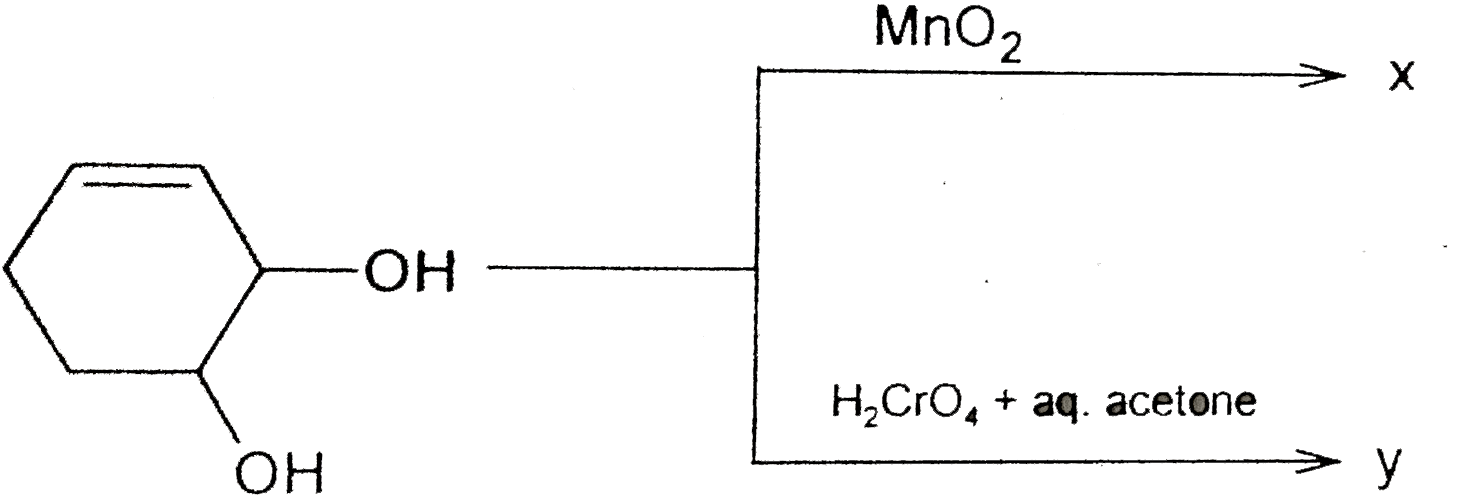An organic compound 'X' on treatment with pyridinium chlorochromate in dichloromethane gives compound 'Y'. Compoun 'Y', reacts with I2 and alkali to form tri-iodomethane. The compound 'X' is :
C2H5OH
CH3CHO
CH3COCH3
CH3COOH
The correct Answer is:A
To solve the problem step by step, we will analyze the information provided and deduce the structure of compound 'X'.
Step 1: Identify the reaction of compound 'X' with pyridinium chlorochromate (PCC).
- PCC is a mild oxidizing agent that typically converts alcohols to carbonyl compounds (aldehydes or ketones).
- Therefore, compound 'X' must be an alcohol because it is being oxidized to a compound 'Y' (which is a carbonyl compound).
Step 2: Determine the nature of compound 'Y'.
- Since compound 'Y' is formed from the oxidation of an alcohol, it can either be an aldehyde or a ketone.
- The next part of the question states that compound 'Y' reacts with iodine (I2) and alkali to form triiodomethane (CHI3).
- Triiodomethane is formed from the reaction of iodine with a methyl ketone or an aldehyde that has at least one methyl group adjacent to the carbonyl.
Step 3: Analyze the reaction of compound 'Y' with iodine and alkali.
- The reaction of an aldehyde (specifically, acetaldehyde, CH3CHO) with I2 and NaOH will yield triiodomethane (CHI3).
- This indicates that compound 'Y' must be acetaldehyde (CH3CHO).
Step 4: Identify compound 'X'.
- Since compound 'Y' is acetaldehyde, we can deduce that compound 'X' must be ethanol (C2H5OH), which is the alcohol that gets oxidized to acetaldehyde by PCC.
Conclusion:
- The compound 'X' is ethanol (C2H5OH).
Summary of Reactions:
1. X (C2H5OH) + PCC → Y (CH3CHO)
2. Y (CH3CHO) + I2 + NaOH → CHI3 + by-products
Final Answer:
The compound 'X' is C2H5OH (ethanol).
---
- PCC is a mild oxidizing agent that typically converts alcohols to carbonyl compounds (aldehydes or ketones).
- Therefore, compound 'X' must be an alcohol because it is being oxidized to a compound 'Y' (which is a carbonyl compound).
- Since compound 'Y' is formed from the oxidation of an alcohol, it can either be an aldehyde or a ketone.
- The next part of the question states that compound 'Y' reacts with iodine (I2) and alkali to form triiodomethane (CHI3).
- Triiodomethane is formed from the reaction of iodine with a methyl ketone or an aldehyde that has at least one methyl group adjacent to the carbonyl.
- The reaction of an aldehyde (specifically, acetaldehyde, CH3CHO) with I2 and NaOH will yield triiodomethane (CHI3).
- This indicates that compound 'Y' must be acetaldehyde (CH3CHO).
- Since compound 'Y' is acetaldehyde, we can deduce that compound 'X' must be ethanol (C2H5OH), which is the alcohol that gets oxidized to acetaldehyde by PCC.
- The compound 'X' is ethanol (C2H5OH).
1. X (C2H5OH) + PCC → Y (CH3CHO)
2. Y (CH3CHO) + I2 + NaOH → CHI3 + by-products
The compound 'X' is C2H5OH (ethanol).
Similar Questions
Knowledge Check
- Question 1 - Select One
A halogen compound 'A' on hydrolysis with dilute alkali followed by acidification gives acetic acid. The compound X is :
AClCH2CH2ClBCH3CHCl2CClCH2CHCl2DCH3CCl3

The compounds x an y areView SolutionA halogen compound 'A' on hydrolyses with dilute alkali followed by acidification gives acetic acid. The compound X is:
View SolutionMethylamine on treatment with chloroform and ethanolic caustic
alkali gives foul smelling compound, the compound isView SolutionA compound 'X' on treatment with Br2/NaOH, provided C3H9N, which gives positive carbylamine test. Compound 'X' is :
View SolutionA compound 'X' on treatment with Br2/NaOH, provided C3H9N, which gives positive carbylamine test. Compound 'X' is :
View SolutionAn organic compound A–– react with sodium to form another compound B–– . The compound A–– when heated with concentrated H2SO4 forms diethyl ether . The compound A–– and B–– are respectively
View SolutionThe compound that on treatment with benzene sulphonyl chloride, forms a precipitate solublein alkali is.
View Solution

